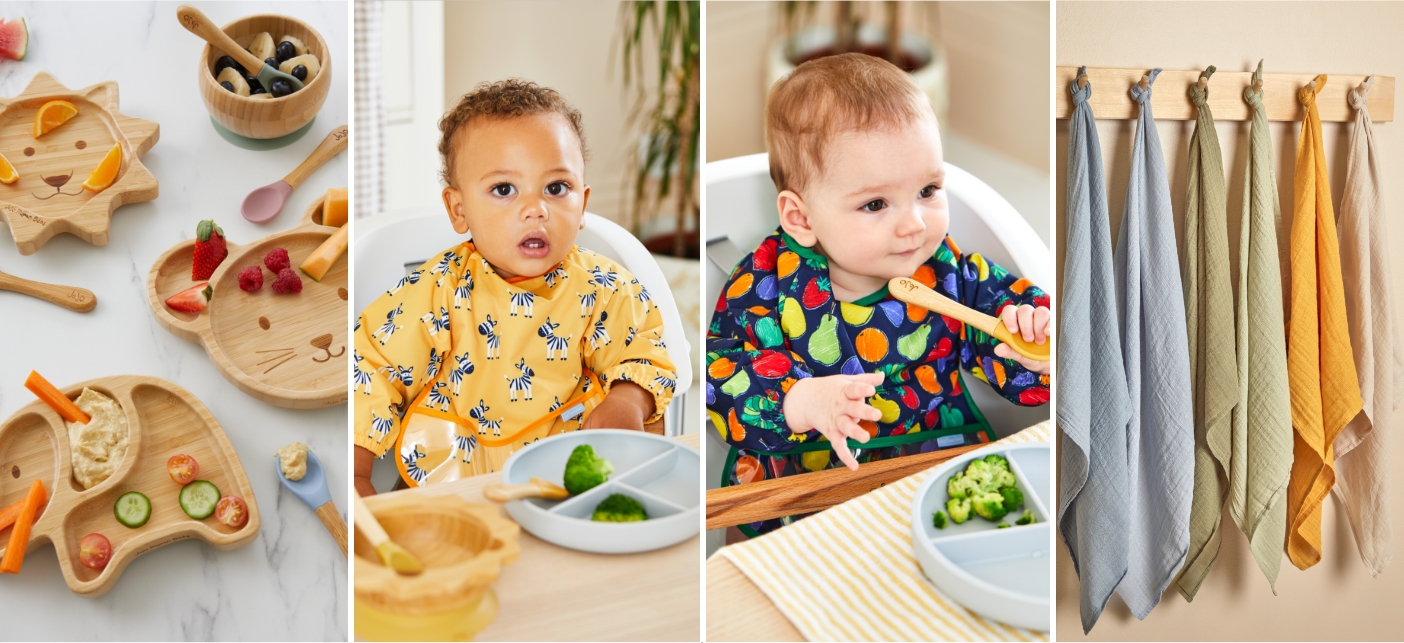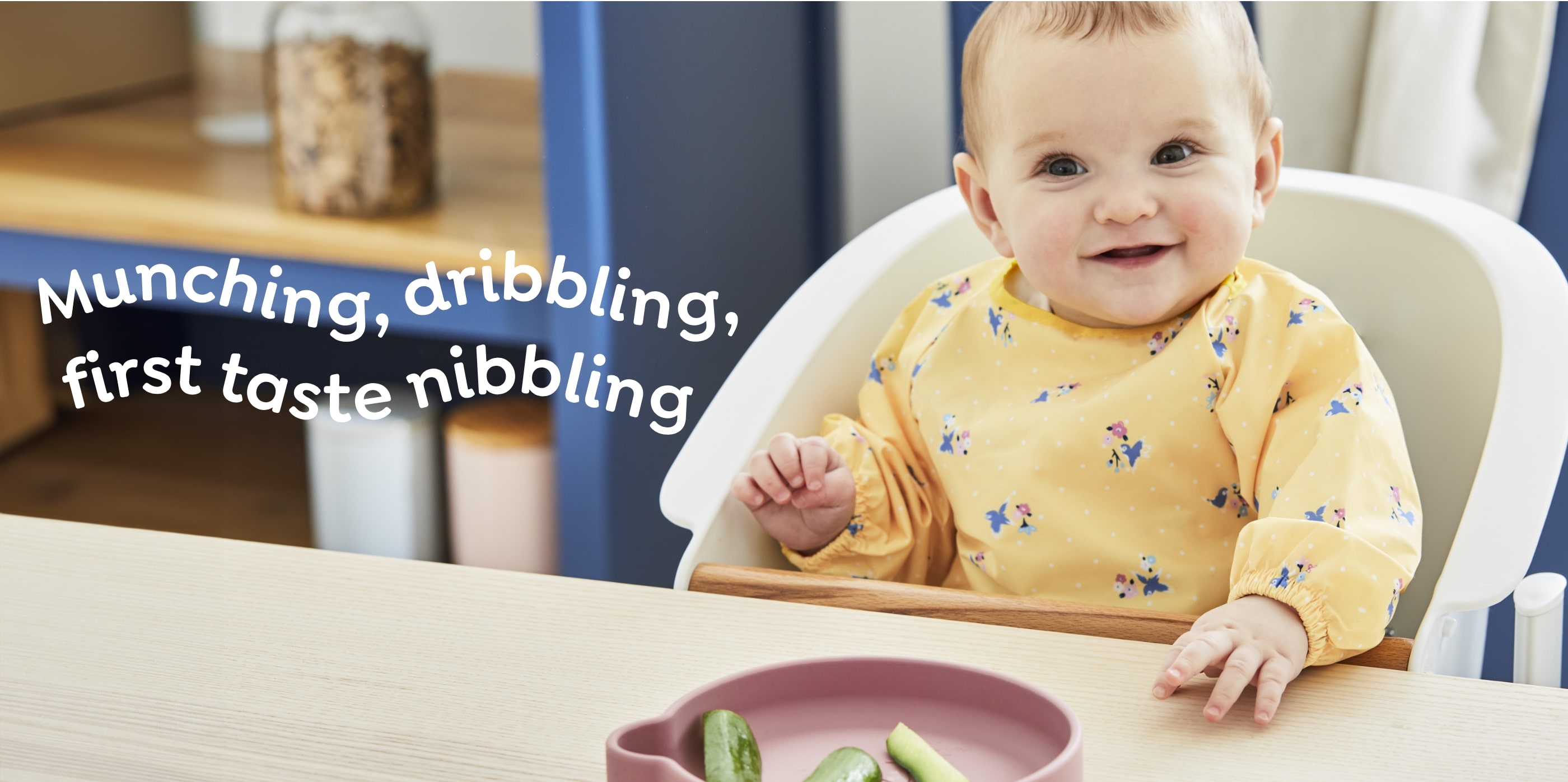First of all, what is weaning? Essentially, it’s giving babies solid foods alongside breast milk or formula. Weaning stops when they stop breastfeeding or bottle feeding and eat solid foods regularly. There are two types of weaning including ‘traditional’ weaning and baby-led weaning. In this guide, we cover both types so you can decide which you prefer, but a lot of parents coincide with both from the very beginning. Let the dribbling, crunching, slurping, munching journey begin!
The ideal time to start weaning your baby is around 6 months old (Stage 1) – this is so they have time to develop and will be more capable of feeding themselves and chewing foods. At this 6 month stage, it’s more about getting them used to the idea of eating solid foods rather than what and how much they’re eating. They’ll still be breastfeeding or bottle feeding, which is where their nutrients are coming from. If your baby was born prematurely, make sure to speak to your doctor for advice on when to start your weaning journey.
Giving your baby their first solid foods comes with mixed emotions – it’s exciting, and moving and perhaps there’s a bit of uncertainty and nerves too. But with the right guidance, they’ll confidently eat their way through solid foods in no time, finding their favourites and dislikes, and knowing their strawberries to their carrots.
You will spot some cues that show they’re ready for solid foods. But remember, stage 1 weaning is about introducing solid foods alongside breastmilk or formula.
It’s important to not be mistaken though when your baby starts chewing their hands and wanting extra milk – these are not signs that they’re ready to wean and are normal baby behaviours.
So your little one is ready to start weaning? That’s so exciting! There are 3 stages of weaning which will take them from puréed and mashed foods to finger foods and beyond! These stages will help guide you on how to start weaning from start to finish.
Let’s start at stage 1: around 6 months old. The first stage of weaning is about introducing them to different smells, tastes and textures rather than getting a whole meal out of it. After all, eating is a big (delicious) skill to master… They’ll need to learn how to chew, mush and swallow foods around in their mouths. Don’t worry about getting 3 meals a day in, they’ll still have their milk to get all their nutrients - so there’s no rush to cram in all their veggies at 6 months.
Don’t feed your baby foods with sugar or salt at this stage (including stock cubes and gravy). This can affect their kidneys and their teeth are very delicate towards sugary foods.[NHS source].
Start small
Tiny babies have tiny tummies – to begin with, stick to small amounts of food. Just a few pieces or teaspoons of food will do. You’ll know if they’re full if they turn their head away and keep their mouth closed. Oh, and if they’re hungry, well, they’ll let you know!
Food before their milk feed
Offer them small pieces of food before their usual milk feed. You want to catch them when they’re hungry - but not too hungry! You can introduce water here too, but avoid cow's milk until they’re at least 1 year old.
Be patient
If they’re not interested, try again tomorrow, or next week. Encouraging them to try different foods can be difficult, but don’t lose faith. It could take them 15 times before accepting a certain food, they’ll have days where they reject everything (totally normal by the way) and days where they fancy everything, it’s all part of the journey.
Eat with them
Babies will copy you when you show them how you eat. Eat with them to encourage the movements and flow of eating. On this note, let them use their hands to feel and feed themselves - they might want to use a spoon too which is great progression! It’s going to get messy, but embrace their development! (See our list of weaning equipment further down).
(from 6 months) For their first weaning foods, try mashed or puréed broccoli, potato, cauliflower, spinach, carrot and apple. Starting with vegetables helps your little one adjust to the bitter taste first, making the sweet tooth from fruits come afterwards. Pouches and packed foods are convenient for when you're short on time or out and about. In an ideal world, it’s best to feed them homecooked foods, as these will have different textures.
The difference between traditional weaning and baby-led weaning pulls in a lot of opinions and debate, but it’s important to go on the weaning journey that suits your and your baby's way of life. It’s a no-judgement zone at JoJo - we’re here to offer advice so you can decide the best way to wean. Actually, a lot of parents do both as a middle ground!
So, what is baby-led weaning? It’s when you feed them only solid foods such as avocado, banana or mini rice cakes from the very start of weaning (6 months). They’ll learn to feed themselves and skip the spoon-feeding, puréed way. Instead, you give them small soft pieces of solid finger foods where they can hold it and explore the food themselves.

Blink and before you know it they’ll be moving on to more solid foods, aiming for 3 meals a day and having less milk by the day - you might save these milk feeds for when you're out or at bedtime for convenience. They might not even want milk at this stage – but a lot of babies still do and that’s also okay! As and when you reduce their milk feeds, you’ll need to increase the variety of foods you’re introducing so they’re getting enough nutrients.

As your little one grows in confidence, it’s time to start giving them mashed foods and finger foods. Babies do not need sugar and salt added to their foods, even at stage 2.
Fruit and vegetables, including broccoli, cauliflower, spinach and cabbage
Potatoes, bread, rice, pasta and other starchy foods
Beans, pulses, fish, eggs and other non-dairy sources of protein
Pasteurised full-fat dairy products, such as plain yoghurt and cheese (choose lower salt options)
(from 10 to 12 months)
In the lead-up to their 1st birthday, they’ll be having 3 meals a day alongside their usual milk feed. They might even have a favourite fruit! Lunch and dinner can include a main and a piece of fruit or yoghurt to mimic a dessert – just to prepare them for toddler eating habits. Stick to finger foods and meals with foods given to them through the weaning journey. Babies do not need sugar and salt added to their foods, even at stage 3.
Once they’re 12 months old, they’ll be eating their way through 3 meals a day, with very little to no more milk feeds. If you’re still breastfeeding, aim to limit the milk feeds so there’s room for more solid foods. At 12 months old, babies can digest cow’s milk and unsweetened milk alternatives, such as soya, oat or almond, which a lot of parents use as an alternative to breastmilk and formula. They might even have tummy room for a snack or two in between meals!
Children under 5 years old should not be given rice drinks because of the levels of arsenic in these products [NHS source].

Food can be a tricky one when it comes to avoiding bacteria, food poisoning and hygiene standards… especially when your mini-mes are so tiny and delicate. But don’t panic or let this put you off - chances are you’re doing all of the basics already!
Clean hands - Always wash your hands before preparing food and after handling raw meat, shellfish, raw vegetables and eggs. Make sure baby’s hands are clean before eating too
Store meat in covered containers on the bottom fridge shelf to stop any drips from falling onto other foods
Cook all foods until piping hot, but cool down before feeding
Don't save and reuse leftover foods that they didn’t eat
Wash and peel fruit and veg
Food stored in the fridge should be eaten within 2 days
Frozen food should be defrosted thoroughly before reheating

JoJo’s here to help your weaning journey, with all the helpful bits and pieces you need to get going: from bibs. and bowls. to cups. and cutlery. Start the right way with a highchair, ready for family meal times complete with a tray and straps for sturdy eating. Even if you’re on the go, our Pack Away Pocket Highchairs are brilliant for eating away from the dinner table… Once you've tried one of these, you'll wonder how you coped before! Add some adorable dinnerware sets into the mix; each set is made using food-safe materials including silicone and polypropylene. They’re designed with messy munchers in mind, from suction pads to reduce spills to perfectly sized plate sections to keep fussy foodies happy. Sadly, if you thought we were going to give you the perfect solution to a mess-free meal, we can't! But, it’s nothing a muslin square. can’t handle. Use these handy cloths to mop up spills and wipe mucky chops. To keep food mess to a minimum, don’t forget to put them in a bib; whether it’s a long-sleeved bib to keep outfits clean, a towelling bib for dribbles or a silicone bib that snaps on in seconds, they sure catch the crumbs.

Are you sure you want to navigate away from this site?
If you navigate away from this site
you will lose your shopping bag and its contents.

